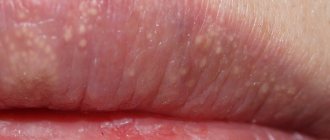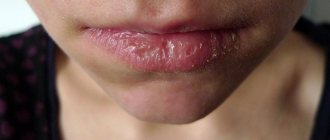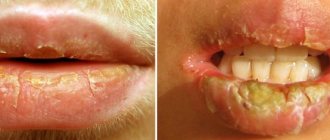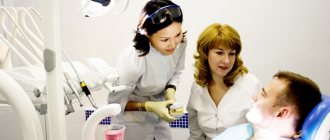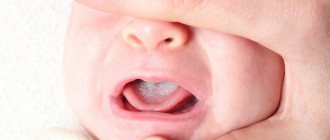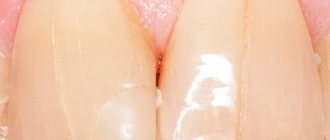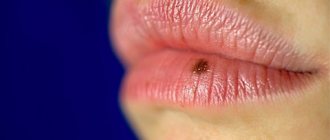general description
Chronic fissure of the lip (K13.08) is a chronic pathology of the red border of the lips, mucous membrane and corners of the mouth with periods of improvement and exacerbation.
Causal factors: dry lips, chronic trauma to teeth/dentures. Predisposing factors: individual anatomical features (deep fold in the center of the lip), smoking, neuroses (frequent licking, biting), vitamin deficiencies, diabetes mellitus, diseases of the digestive tract.
A cracked lip lasts a long time—5–10 years. The age of patients is 8–80 years. More common in men (70%). Cracks are localized on the lower lip in the center (65%), on the upper lip (24%), in the corner of the mouth (11%).
Cracks on lips
10.04.2019
Modern dentistry is more than a medical institution.
Aesthetic services are consistently in demand among our patients. Teeth whitening and professional cleaning, installing sky bridges and straightening the smile line with veneers - all this is what our patients choose to look beautiful, young and well-groomed. At the same time, we, doctors, believe that true beauty always goes hand in hand with health. Today we want to talk about such a pressing problem as the appearance of cracks on the lips in the spring. The skin on the lips is thin and vulnerable, it does not have sebaceous glands, which means there is no fatty film that would protect against cold, heat or wind. Sometimes with the onset of spring, cracks appear on the lips. Probably every woman has encountered this phenomenon. Cracks spoil the appearance, cause inconvenience, interfere with a natural and open smile, causing discomfort. Today's UniDent article is about what causes them, how to prevent them and how to cure them at home yourself.
Why do cracked lips appear in spring?
The fact is that the delicate skin of the lips reacts to temperature changes, which are frequent during the changing seasons. In addition, spring vitamin deficiency plays a role, especially deficiency of vitamins A and E.
The skin of the lips also reacts to bad habits - smoking, love of strong coffee and salty foods.
In addition, some people have the habit of frequently licking their lips. Saliva, which contains enzymes and acids, also irritates and dries out the lips.
Dry, cracked lips can indicate certain diseases, such as diabetes. Therefore, if the cracks do not go away for a long time, it is better to consult a doctor.
If there are no diseases, but your lips are still cracking, you can try to cope with this problem yourself.
Preventing chapped lips
To protect your lips from the vagaries of the weather in spring, before going outside, you need to lubricate them with a protective balm or hygienic lipstick. The composition of such a product should be natural and include beeswax or vegetable wax, lanolin. These substances create a protective film.
Vitamins C and B12, as well as sun protection factor, will also help. It is better to choose a lipstick or gloss that contains these ingredients and renew the layer regularly.
It’s a good idea to nourish your skin with vitamins not only from the outside, but also to ensure they are supplied with food. To do this, you need to eat natural products, not fast food. The more varied the diet, the better for the skin. If you have to go on a diet, you can pick up a vitamin complex for yourself at the pharmacy.
Lip skin restoration
But what to do if there are already cracks? Engage in skin restoration and do everything for their speedy healing.
Those who are not allergic to honey can try honey masks. It takes a minimum of time. Just apply honey on your lips and wait 10 minutes - that's all. It’s even better if you apply this mask at night. Of course, not in a thick layer, but simply after applying the mask, walk around for a short time, then dry your lips a little with a napkin and, most importantly, do not wash off the mask completely.
A mixed mask - honey with olive oil - is useful and nutritious. This mixture can also be left overnight according to the same rules. The effect will be noticeable, the cracks will heal quickly.
It’s a good idea to lubricate your lips with oil alone, this will also benefit the skin.
A salt compress before bed is suitable for care. Dissolve half a teaspoon of sea salt in a glass of water, moisten a cotton swab with this mixture and press it to your lips for 5 - 10 minutes. Then apply oil or rich cream.
Regular care will help get rid of unpleasant cracks in the skin of your lips, look well-groomed and make your smile healthy and beautiful.
We wish you to smile joyfully and enjoy your health every spring day!
With love, UniDent.
Share information with friends:
Treatment of chronic cracked lips
Treatment is prescribed only after confirmation of the diagnosis by a medical specialist. Local conservative treatment is carried out (keratoplasty (rosehip oil, sea buckthorn, radevit), anti-inflammatory ointments, glucocorticoid ointments, novocaine (lidocaine) blockades with 0.25/0.5/1% solutions, inserted with a thin needle under the base of the crack from the mucous membrane ), laser therapy, vitamin therapy.
Essential drugs
There are contraindications. Specialist consultation is required.
- Aevit (a drug that reduces the fragility and permeability of blood vessels). Dosage regimen: orally, at a dose of 0.2 g 3 times a day. The course of treatment is 1 month.
- Methyluracil (regeneration stimulating agent). Dosage regimen: orally, at a dose of 0.5 g 3 times a day. The course of treatment is 1 month.
- Lorinden S (antibacterial, antifungal, anti-inflammatory agent). Dosage regimen: lubricate the corners of the mouth and perioral skin with a thin layer of ointment 2-3 times a day. The course of treatment is 7-10 days.
- Traumeel S (homeopathic anti-inflammatory drug). Dosage regimen: lubricate the corners of the mouth and perioral skin with a thin layer of ointment 2-3 times a day. The course of treatment is 7−14 days.
Symptoms of seizures in the corners of the mouth
Clinical manifestations and symptoms of the lesion depend on many factors and stages. It usually begins with redness of the skin in the corners of the mouth, peeling, and the appearance of bursting blisters. Areas of erosion appear on the mucous membrane and skin of the corner, which become covered with a crust, when ruptured, cracks of varying depths can form.
In areas of inflammation, constant itching is felt, pain appears when opening the mouth, pain when eating spicy food. It is especially typical that a sharp pain appears in the morning, after sleep, when you first open your mouth.
But in some rare cases, obvious pain symptoms are mild, especially in elderly people, or in people suffering from diabetes mellitus (when seizures appear as a consequence of candidal stomatitis).
Incidence (per 100,000 people)
| Men | Women | |||||||||||||
| Age, years | 0-1 | 1-3 | 3-14 | 14-25 | 25-40 | 40-60 | 60 + | 0-1 | 1-3 | 3-14 | 14-25 | 25-40 | 40-60 | 60 + |
| Number of sick people | 0 | 2 | 3 | 10 | 10 | 10 | 5 | 0 | 2 | 3 | 5 | 5 | 5 | 2 |
Causes of sticky spots in the corners of the mouth
for the appearance of seizures (more precisely, provoking factors) can be very diverse, although ultimately the cause is the action of microorganisms (i.e., infections) that cause limited inflammatory damage to areas of the skin and mucous membranes.
Bacterial infections. Mainly epidermal streptococci or staphylococci.
Fungal infections. Mainly by fungi of the genus Candida, sometimes against the background of candidal stomatitis.
Viral infections. Mainly by herpes simplex virus type 1, but more often against the background of herpetic stomatitis in the oral cavity. As a direct cause, they are less common.
The corners of the mouth are an almost ideal place for the accumulation and reproduction of microorganisms, which is facilitated by constant humidity, the presence of residual nutrients, and the relative enclosure of the space. But for the appearance of seizures in the corners of the mouth, provoking factors are necessary, which can be conditionally classified as external (for example, mechanical, local allergic, etc.) and internal (seizures as a manifestation of other diseases).
Dry mouth. Cracks in the corners of the mouth can be caused by excessive dryness of the oral mucosa (xerostomia).
Allergic reactions. For example, for cosmetics, for the components of ballpoint pens (if you have a habit of holding the tip in your mouth). But more often - on nickel-containing dentures.
Other external factors. As a rule, they contribute to bacterial infection in the corners of the mouth. Using dirty vegetables and fruits, regularly licking the corners of the mouth (which contributes to local stagnation of saliva), squeezing skin formations (such as pimples) on the lips, scratching this area, hypothermia of the entire facial area. External factors can also include long-term use of certain medications: antibiotics, hormone therapy drugs, as well as prolonged elevated body temperature.
General lesions of the oral mucosa. Inflammations of the oral mucosa of various types can lead to the appearance of jams in the corners of the mouth.
Common diseases as provoking factors. Among them: metabolic pathologies (for example, diabetes mellitus), Down syndrome (with an increased susceptibility to infections), Parkinson's disease (the corners of the mouth are constantly moist), various types of anemia (especially iron deficiency), immunodeficiency conditions, liver pathologies, hypovitaminosis ( deficiency of vitamin B2, B12, B6 or B3), lack of microelements in the body (zinc), pathologies of the gastrointestinal tract.
Non-infectious causes
- Irritation from underwear . Fabrics that come into contact with cheap knitwear become inflamed, which causes cracks to form.
- Overuse of antibacterial soaps and intimate sprays . Their use causes dryness and cracking of the mucous membrane.
- Using cheap condoms , which cause allergies and irritation.
- Douching , during which the mucous membrane of the genital tract dries out and the normal secretion of secretions is disrupted. The labia minora area begins to dry out and become cracked.
- Vitamin deficiency - cracks can be caused by improper nutrition with a minimum amount of vitamins, used during strict diets.
- Hormonal disruptions characteristic of the menopause. At this time, in women, the concentration of sex hormones decreases, which is accompanied by dryness and itching of the mucous membranes, on which cracks can form.
Folk recipes
In addition to traditional methods, there are many folk remedies for treating cracked lips.
- Natural honey. It acts as an antiseptic and soothes painful wounds. Unlike traditional medicines, honey has no restrictions on its use - you can lubricate your lips with natural sweetness at least every hour.
- Natural aloe juice. It is recommended to apply freshly cut aloe leaf to cracks for several days in the morning and evening.
- Butter or rendered animal fat. You can find effective remedies in your refrigerator and lubricate your lips with oil.
Treatment
If the condition is not associated with infection, patients are advised to eliminate the cause of mucosal irritation:
- Be careful when choosing underwear.
- Do not overuse antibacterial sprays and douching solutions.
- Choose contraceptives that do not contain 9-nonoxynol.
If an STD is detected, the identified pathogens are eliminated. Often the lesion is combined and the patient has several infections that need to be treated. Treatment is carried out simultaneously with a partner. After completion of treatment, prebiotics and probiotics are prescribed to normalize the flora.
For local treatment of cracks, the use of agents that promote the healing of cracks, restoration of mucous membranes, and relief of inflammation, irritation and dryness is indicated. As an aid, it is recommended to wash with infusions of calendula and chamomile.
Only comprehensive treatment prescribed by a doctor will help completely get rid of the problem.
Traditional Treatments
First, let's look at the traditional methods recommended by dermatologists.
- Ointments containing calendula oil. This plant heals inflammation in the corners of the lips (so-called jams) and soothes irritation in inflamed areas.
- Products based on lanolin. Preparations in which lanolin acts in combination with beneficial sea buckthorn oil are especially effective.
- A course of vitamins. If your body does not have enough vitamin E, it is better to start taking it in combination with vitamin A (in pairs, the body absorbs them better). You can also take a series of multivitamins - during the cold season, this will not only help the skin heal, but also generally strengthen the immune system.
Symptoms and types of labia fissures
The characteristic signs of this disease are:
- soreness;
- itching;
- burning during urination.
The vessels in the affected area are filled with blood, so hyperemia is observed.
Gynecologists divide cracks in the labia minora and labia majora into two types.
- Spicy. Recent injuries that cause intense pain when touched.
- Chronic. These are microcracks that appeared quite a long time ago. Their edges are calloused and thickened, so the woman experiences pain even if nothing touches the wound. Such formation not only brings unpleasant sensations, but also has an unaesthetic appearance.

